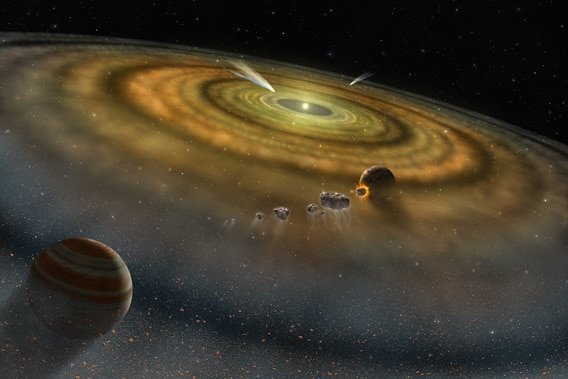Create a free profile to get unlimited access to exclusive videos, sweepstakes, and more!
Alien Comets Swarm Around Other Stars

We know the Sun is surrounded by literally trillions of small icy comets, most so far away they are invisible even to our biggest telescopes, only easily spotted when they approach the Sun. This strongly implies they are common around other stars as well, but finding them has been devilishly tricky. Evidence of only a few has been seen.
Now, though, new observations of six stars show they too have comets orbiting them, which indicates stars with comets may be as common as stars with planetsâ¦and those number in the hundreds of billions!
Comets are sometimes called âdirty snowballsâ, because theyâre composed of rock mixed with ice. That ice itself is a mix of frozen water, carbon dioxide, ammonia, and other things we normally think of as liquids or gases on Earth. But in the depths of space theyâre frozen solid. As a comet approaches the Sun, the ice sublimates, turning directly into gas. The gas expands, reflects sunlight, and the comet gets brighter.
Still, stars are very, very far away, and thereâs no hope of seeing a comet directly. But if the comet passes directly between us and the star, some of the starlight gets absorbed by the comet's gas. Different chemicals absorb different colors of light, so by carefully analyzing the starlight, the presence of a comet can be detected.
The new observations looked at nearby stars that are hotter and more massive than the Sun, and known to possess disks of material from which planets form. Over several nights, they detected exactly the kinds of changes in the light from six of the stars that are expected from the presence of comets.
This brings the number of such cometary systems known up to ten. Given the number seen and the number of stars observedâas well as what we know about how stars, planets, and comets formâthis indicates pretty much every star that has planets has comets, too. And we know a lot of stars have planets!
The leading idea on how planets form is that they clump up in debris disks around stars leftover from their formation. At first the process is slow, with random collisions between particles making them stick together. Over time, when they get big enough, gravity takes over and more matter is drawn in, explosively growing the young planetesimals into full-fledged planets. We see lots of stars with these disks, and lots of stars with planets, but this intermediate step of collisional growth is difficult to spot. These exocomets (and oh, how I love that word!) are a key link between the two steps.
The stars observed with comets are well on their way to forming mature planetary system like ours, sometime in the next few million years, and weâre seeing the baby pictures as it happens.
The more we observe the sky, the more we learn about how we got here. There are so many steps, so many pieces to the puzzle! But we have many eyes on the sky and many brains on the problem, and, piece by piece, the picture becomes more complete all the time.


























